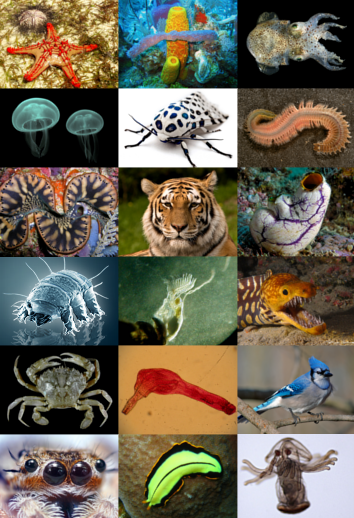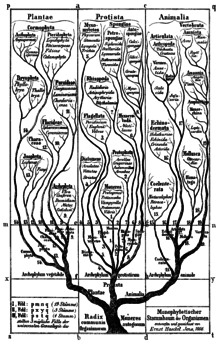Body plan

A body plan (also written bodyplan), Bauplan (German plural Baupläne), or ground plan is "an assemblage of morphological features shared among many members of a phylum-level group".[1]: 33 The vertebrate body plan is one of many: invertebrates consist of many phyla.
This term, usually applied to animals, envisages a "blueprint" encompassing aspects such as symmetry, segmentation and limb disposition.
Body plans have historically been considered to have evolved in a flash in the Cambrian explosion, but a more nuanced understanding of animal evolution suggests the gradual development of body plans throughout the early Palaeozoic.
History
The history of the discovery of body plans can be seen as a movement from a worldview centred on the vertebrates, to seeing the vertebrates as one body plan among many. Among the pioneering zoologists, Linnaeus identified two body plans outside the vertebrates; Cuvier identified three; and Haeckel had four, as well as the Protista with eight more, for a total of twelve. For comparison, the number of phyla recognised by modern zoologists has risen to 35.[1]
Linnaeus, 1735

In his 1735 book, Systema Naturæ, the Swedish botanist Linnaeus grouped the animals into quadrupeds, birds, "amphibians" (including tortoises, lizards and snakes), fish, "insects" (Insecta, in which he included arachnids, crustaceans and centipedes) and "worms" (Vermes). Linnaeus's Vermes included effectively all other groups of animals, not only tapeworms, earthworms and leeches but molluscs, sea urchins and starfish, jellyfish, squid and cuttlefish.[2]
Cuvier, 1817

In his 1817 work, Le Règne Animal, the French zoologist Georges Cuvier combined evidence from comparative anatomy and palaeontology[3] to divide the animal kingdom into four body plans. Taking the central nervous system as the main organ system which controlled all the others, such as the circulatory and digestive systems, Cuvier distinguished four body plans:[4]
- I. with a brain and a spinal cord (surrounded by skeletal elements)[4]
- II. with organs linked by nerve fibres[4]
- III. with two longitudinal, ventral nerve cords linked by a band with two ganglia below the oesophagus[4]
- IV. with a diffuse nervous system, not clearly discernible[4]
Grouping animals with these body plans resulted in four branches: vertebrates, molluscs, articulata (including insects and annelids) and zoophytes or radiata.
Haeckel, 1866
Ernst Haeckel, in his 1866 Generelle Morphologie der Organismen, asserted that all living things were monophyletic (had a single evolutionary origin), being divided into plants, protista, and animals. His protista were divided into moneres, protoplasts, flagellates, diatoms, myxomycetes, myxocystodes, rhizopods, and sponges. His animals were divided into groups with distinct body plans: he named these phyla. Haeckel's animal phyla were coelenterates, echinoderms, and (following Cuvier) articulates, molluscs, and vertebrates.[5]
Gould, 1979
Stephen J. Gould explored the idea that the different phyla could be perceived in terms of a Bauplan, illustrating their fixity. However, he later abandoned this idea in favor of punctuated equilibrium.[6]
Origin
Many body plans originated in the Cambrian period.[7] in the "Cambrian explosion",[8] However, complete body plans of many phyla emerged much later, in the Palaeozoic or beyond.[9]
The current range of body plans is far from exhaustive of the possible patterns for life: the Precambrian Ediacaran biota includes body plans that differ from any found in currently living organisms, even though the overall arrangement of unrelated modern taxa is quite similar.[10] Thus the Cambrian explosion appears to have more or less completely replaced the earlier range of body plans.[7]
Genetic basis
Genes, embryos and development together determine the form of an adult organism's body, through the complex switching processes involved in morphogenesis.
Developmental biologists seek to understand how genes control the development of structural features through a cascade of processes in which key genes produce morphogens, chemicals that diffuse through the body to produce a gradient that acts as a position indicator for cells, turning on other genes, some of which in turn produce other morphogens. A key discovery was the existence of groups of homeobox genes, which function as switches responsible for laying down the basic body plan in animals. The homeobox genes are remarkably conserved between species as diverse as the fruit fly and man, the basic segmented pattern of the worm or fruit fly being the origin of the segmented spine in man. The field of animal evolutionary developmental biology ('Evo Devo'), which studies the genetics of morphology in detail, is rapidly expanding[11] with many of the developmental genetic cascades, particularly in the fruit fly Drosophila, catalogued in considerable detail.[12]
See also
- Anatomical terms of location
- Arthropod head problem
- Deep homology
- Definition of Phylum based on body plan
- Ediacaran biota
- Macroevolution
- Precambrian body plans
- Sean B. Carroll
- Segmentation (biology)
- Supernumerary body part
- Symmetry in biology
References
- ^ a b Valentine, James W (2004-06-18). On the Origin of Phyla. ISBN 9780226845487.
- ^ Linnaeus, Carolus (1735). Systema naturae, sive regna tria naturae systematice proposita per classes, ordines, genera, & species. Leiden: Haak. pp. 1–12.
- ^ Reiss, John (2009). Not by Design: Retiring Darwin's Watchmaker. University of California Press. p. 108. ISBN 978-0-520-94440-4.
- ^ a b c d e De Wit, Hendrik Cornelius Dirk De Wit. Histoire du Développement de la Biologie, Volume III, Presses Polytechniques et Universitaires Romandes, Lausanne, 1994, p. 94-96. ISBN 2-88074-264-1
- ^ Haeckel, Ernst. Generelle Morphologie der Organismen : allgemeine Grundzüge der organischen Formen-Wissenschaft, mechanisch begründet durch die von Charles Darwin reformirte Descendenz-Theorie. (1866) Berlin
- ^ Bowler, Peter J. Evolution: the History of an Idea (2009) California, p. 364.
- ^ a b Erwin, Douglas; Valentine, James; Jablonski, David (1997). "Recent fossil finds and new insights into animal development are providing fresh perspectives on the riddle of the explosion of animals during the Early Cambrian". American Scientist (March–April).
- ^ Erwin, D. H. (1999). "The Origin of Bodyplans". Integrative and Comparative Biology. 39 (3): 617–629. doi:10.1093/icb/39.3.617.
- ^ Budd, G. E.; Jensen, S. (2000). "A critical reappraisal of the fossil record of the bilaterian phyla". Biological Reviews of the Cambridge Philosophical Society. 75 (2): 253–95. doi:10.1111/j.1469-185X.1999.tb00046.x. PMID 10881389.
- ^ Antcliffe, J. B.; Brasier, M. D. (2007). "Charnia and sea pens are poles apart". Journal of the Geological Society. 164: 49. doi:10.1144/0016-76492006-080.
- ^ Hall, Brian K. (28 March 2005). "Evo Devo is the New Buzzword..." Retrieved 13 September 2014.
- ^ Arthur, Wallace. (1997). Animal Body Plans. Cambridge England: Cambridge University Press. ISBN 0-521-77928-6.
External links
- Videos
